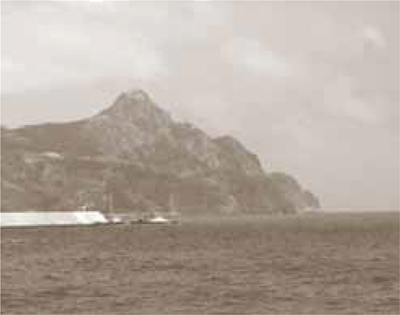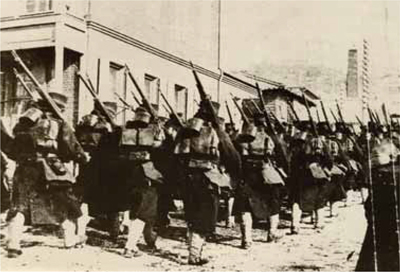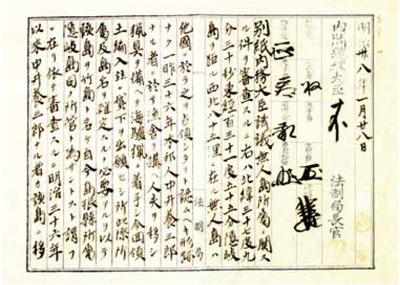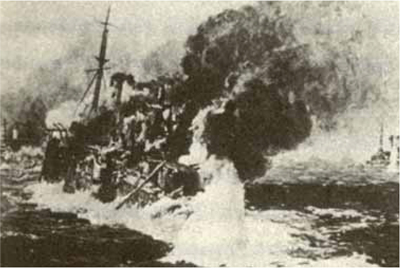- Dokdo in the East Sea
- Controversies surrounding Dokdo
- The History of Dokdo
Dokdo in the East Sea
Table of Contents Open Contents
The First Sign of Invasion: The Japanese Seizure of Dokdo
The lyrics to verse five of the song Our Land, Dokdo are as follows:
-
“For the Japanese to falsely claim that Dokdo was an island without an owner after the Russo-Japanese War troubles us greatly. Yisabu, the Silla general, is laughing in his grave. Dokdo is our land.”
The plan to invade Joseon was first proposed by Yoshida Shōin in the 1850s. Afterwards, Kido Takayoshi, Saigō Takamori, and others belonging to the “Conquer Korea Advocates”(seikanronsha)[note 001] followed in his footsteps.
Japan actualized its plan to invade Joseon [Korea] in 1894, around the time of the Sino-Japanese War. It had been planning this invasion for a long time, and took advantage of the Revolutionary Uprising of the Donghak Peasant Army of 1894 to deploy troops to occupy the royal palace and other strategic places in Seoul, and in Busan, Incheon, and Wonsan. Japan converted the buildings of central government offices such as the Sayeok-won (the Bureau of Interpreters) and the Jangakwon (the Bureau of Music) into military barracks, installed military telegraph lines stretching across the entire country from Seoul to Busan and from Seoul to Incheon, and laid railroad tracks to use all these for the war against China. The Japanese battled the Chinese from the open sea of Pungdo off Asan Harbor to Pyeongyang and the Yellow Sea, devastating Joseon’s land and seas in the process.
Japan prevailed over China and gained influence not only over Joseon but also possession of the Liaodong Peninsula. However, Russia, France, and Germany intervened and left Japan with no choice but to pull back. Russia’s expanding influence in Joseon at this time was particularly irksome to Japan.
Japan knew that if it did not expel Russia from Korea, it would not be able to achieve its objective of using the peninsula as a military base. Therefore, Japan spared no efforts in ridding Korea of Russian influence. Japan, concerned by the increasing pro-Russian sentiment among the Joseon elite, ended up assassinating Empress Myeongseong (also known as Queen Min), who was behind the pro-Russian policy.
Japan, having undergone the humiliation of having to return the Liaodong Peninsula to Qing China due to the Triple Intervention, took the long-awaited opportunity on February 8, 1904, to launch a surprise attack against two Russian warships in Lushun Harbor. This marked the beginning of the Russo-Japanese War. On the same day, the Japanese army ignored the Joseon government’s declaration of neutrality and began penetrating the peninsula through Incheon, Namyang, Gunsan, and Wonsan. The Kikoshi Brigade, the advance party of the Japanese army, entered Seoul on February 9. They were followed by the main force, the Twelfth Army Division led by Inoue Hikaru. Japan planned much more meticulously this time to transform Korea into a military base, which it had failed to do ten years earlier during the Sino-Japanese War.
On February 23, 1904, the Japanese army surrounded the royal palace, threatened the royal household and government, and forced the signing of the Korea-Japan Protocol Agreement[note 002]. Based on this document, Japan expanded its authority to occupy or expropriate areas deemed necessary for the stationing of troops or ones with strategic military value. Japan’s efforts to annex Joseon had become even more conspicuous.
-
- Article Four of the Korea-Japan Protocol
-
In case of danger to the safety of the royal household of the Korean Empire or loss of national territory due to invasion by a third country or internal rebellion, the Japanese will rapidly act to take the necessary measures. The government of the Korean Empire will cooperate fully to facilitate Japanese initiation of these efforts. In order to carry out the above, the Japanese government will occupy areas of strategic military importance as is needed.
The Japanese also established fortresses in Yeonghung Bay and Jinhae, proclaimed martial law in those places, and seized the land these fortresses had occupied. By the end of July 1905, the Japanese tried to force Joseon into handing over as much as 9,750,000 pyeong (38,547,500 square yards) of land for military use in Yongsan, Pyeongyang, and Uiju.
With the situation being what it was, there was absolutely no way Ulleungdo and Dokdo, which were places of strategic importance to the Japanese in the war against Russia, could escape the seizure by Japan. Since the early stages of the Russo-Japanese War, the Japanese Army had become well aware of the strategic value of these islands. Ulleungdo and Dokdo formed the strategic axis where the southward-bound Russian Vladivostok Fleet and the combined Japanese fleet collided. The Russian fleet threatened Japan’s control of the seas, and on the days around May 15, 1904, the Japanese navy had already lost a third of its forces.

Manghyang Peak in Japanese-occupied Sadong Village, Ulleungdo, where the watchtower had been installed

Ulleungdo and Dokdo were absolutely vital to Japan’s battle plans. On May 18, 1904, Japan tried to force the Korean Empire into depriving Russia of the timber-felling rights to Ulleungdo which it had gained from the Empire, and then eliminated all Russian influence from the island by blockading it. On September 1, Japanese forces constructed two watchtowers each for the east and west sides of Ulleungdo. Next, in order to install one watchtower on Dokdo as well, the Japanese dispatched the warship Nitaka-maru to survey the island. The Nitaka-maru departed on September 24, five days before a man named Nakai Yosaburō submitted a written application to the Japanese government for the incorporation of Dokdo into Japan.
Nakai Yosaburō was a commercial fisherman who plied his trade along foreign coastlines in a diving suit, and had been scheming to secure a monopoly over the numerous sea lions[note 003] that inhabited Dokdo. When he first hatched his scheme, he knew that Dokdo was Korean territory and sought to submit a temporary-lease petition for the island to Joseon through the Japanese government. However, Kimotsuki Kaneyuki, Director of the Hydrographic Office in the Ministry of the navy, incited Nakai to submit a petition to the Japanese government on September 29 to incorporate Dokdo into the national territory.
When Nakai submitted “A Request for the Incorporation of the Liancourt Islands into Japan’s National Territory and for its Lease”(Riyankotō Ryōdo hennyū narabi Kashisage negai), a director named Inoue of the Home Ministry protested.
-
“If we incorporate a worthless piece of rock which is suspected of being sovereign Korean territory, many foreign countries with their eyes on Japan will become greatly convinced that we intend to annex Korea.”
- - Nakai Yosaburō’s Summary of Business in Dokdo, 1906
-
“At this juncture it is necessary to incorporate Dokdo into Japanese territory. Would not it be most desirable to install watchtowers, wireless, and submarine cables to keep track of enemy warships?”
- - Nakai Yosaburō’s Summary of Business in Dokdo, 1906
On January 1, 1905, the Japanese takeover of Lushun from the Russians marked a turning point in the war. Admiral Tōgō Heihachirō, supreme commander of the Japanese combined fleet, ordered all Japanese warships to gather in the Korea Strait to crush the Russian Baltic Fleet coming through the Indian Ocean. After having surrendered Lushun to the Japanese, it was obvious the Russian Baltic Fleet would have to pass through the straits to sail towards Vladivostok.
During this critical juncture, the Japanese wartime cabinet initiated concrete plans to seize Dokdo. On January 10, Home Minister Yoshikawa Akimasa sent a secret message to Prime Minister Katsura Tarō, entitled “The Case Regarding the Uninhabited Island”(Munintō shozoku ni kansuru ken), which requested the opening of a cabinet meeting to incorporate Dokdo. On January 28, the prime minister, navy minister, and eleven cabinet members made the decision to add Dokdo to Japan.
-
“Documents clearly attest to a man known as Nakai Yosaburō having emigrated to these islands and pursued the occupation of fishing, proof according to international law of occupation and hence evidence of Japanese jurisdiction. Therefore, our cabinet have filed the decision to make these islands subordinate to the Oki Islands Branch Office of Shimane Prefecture.”
- - The Japanese Cabinet’s Written Decision to Incorporate Dokdo, January 28, 1905
Since the Russian Baltic Fleet had already taken seven months to finally reach the Korea Strait on May 27, 1905, the condition of the fleet was at its worst. The sailors of the Baltic Fleet were worn out beyond exhaustion, and right after they encountered the Japanese combined fleet - which had been prepared in every regard - their ships were sunk one after the other. Admiral Zinovi Petrovich Rozhdestvenski, supreme commander of the wounded Baltic Fleet, was captured as a prisoner of war in the seas near Ulleungdo. Rear Admiral Nikolai Ivanovich Nebogatov replaced the admiral as supreme commander and fled the Japanese fleet all night long, but was captured as a prisoner of war on the morning of May 28 in the seas near Dokdo. This was the moment in which the Russian Baltic Fleet was completely destroyed by the Japanese combined fleet.
The Japanese forces, which had decimated the Russian Baltic Fleet in the seas near Ulleungdo and Dokdo, only grew more keenly aware of the strategic value of these islands. Russia still retained extraordinary military power, and since Japan did not know when she might have to war with Russia again, Japanese forces installed an additional watchtower on the northern part of Ulleungdo as well as another one on Dokdo, which had a view of Ulleungdo. The Japanese Navy deployed the Hashidate-maru in June to conduct another survey of Dokdo. They began construction on the observation tower on July 25 and finished on August 19.
Although Japan had thought the war would last much longer, the Portsmouth Treaty[note 004] was concluded on September 5, much earlier than expected. The watchtower on Dokdo had lost its reason for being and was demolished on October 24.
The Japanese forces installed a submarine cable between Ulleungdo and Dokdo on October 8, and another between Dokdo and Matsue in Japan on November 9. Although the war was over, the Japanese forces did not hide their ambition to proceed from the installation of facilities on Dokdo to the annexation of Korea.

Japanese newspaper with a photo of Dokdo, described as a memorial place of the Russo-Japanese War (1906)

Immediately after the war with Russia, Japan forced the signing of the Korea-Japan Protocol Agreement in February, 1904, the Korea-Japan Agreement in August, 1904, the Treaty of 1905 (also known as Protectorate Treaty), The Korea-Japan New Agreement in July 1907, and the Treaty of Annexation in August 1910, concluding Japan’s plans to absorb the Korean Peninsula.
In the final analysis, the first target of Japanese imperialism in its plan to annex Korea was the seizure of Dokdo.
- [note 001]
- In the 1870s, in Japanese political circles those advocating the invasion of Korea gained great power. After the Meiji Restoration of 1868, Japan’s political world was split into two camps: a modernized bureaucratic force which sought progress for the country through further modernization, and conservatives who opposed the changes wrought by modernization. Hawkish conservatives became the core force of the latter camp, and they sought to deflect discontent felt by the warrior class by pushing for an invasion of Joseon.
- [note 002]
- Japan, which had initiated the Russo-Japanese War, forced the Korean Empire (Daehan Jeguk in Korean; in 1897, King Gojong proclaimed the founding of this Korean empire) to enter into a cooperative relationship with Japan through the forced signing of this treaty. An important part of this document stipulates that the government of the Korean Empire allow Japanese use of areas of strategic value whenever the Japanese deemed it convenient. The forced signing of this treaty can be seen as the first step in the colonization of the Korean empire. The house of Yi Ji-yong (one of the cosigners) was set aflame, showing how strong opposition was to the forced signing of this agreement.
- [note 003]
- Sea lions are similar to seals, and also have short fur and webbed feet with claws. They grow to around two meters in length and live in packs, feeding upon anchovies, cuttlefish, and saury. At one time Dokdo was even known as “Gajido,” or the “Isle of the Sea Lions,” because so many of these animals lived there. However, fueled by their countrymen’s desire for leather, Japanese hunters indiscriminately killed as many of these animals as possible. Now no trace is left of the sea lion on Dokdo.
- [note 004]
- In the naval port town of Portsmouth, New Hampshire, United States President Theodore Roosevelt provided his kind offices to end the Russo-Japanese War through peace talks. Through the treaty produced via these talks, Japan’s desire to lead, protect, and supervise Joseon was recognized. In addition, Japan was given leasing rights to Lushun and Dalian from China, the right to lay railroad tracks south of Changchun, ownership of Russian Sakhalin south of 50 degrees north latitude, and fishing rights off the coasts of Russia in the East Sea, the Sea of Okhotsk, and the Bering Sea.
[note 001]
The Conquer Korea Advocates
In the 1870s, in Japanese political circles those advocating the invasion of Korea gained great power. After the Meiji Restoration of 1868, Japan’s political world was split into two camps: a modernized bureaucratic force which sought progress for the country through further modernization, and conservatives who opposed the changes wrought by modernization. Hawkish conservatives became the core force of the latter camp, and they sought to deflect discontent felt by the warrior class by pushing for an invasion of Joseon.
닫기
[note 002]
The Korea-Japan Protocol Agreement
Japan, which had initiated the Russo-Japanese War, forced the Korean Empire (Daehan Jeguk in Korean; in 1897, King Gojong proclaimed the founding of this Korean empire) to enter into a cooperative relationship with Japan through the forced signing of this treaty. An important part of this document stipulates that the government of the Korean Empire allow Japanese use of areas of strategic value whenever the Japanese deemed it convenient. The forced signing of this treaty can be seen as the first step in the colonization of the Korean empire. The house of Yi Ji-yong (one of the cosigners) was set aflame, showing how strong opposition was to the forced signing of this agreement.
닫기
[note 003]
Sea Lions
Sea lions are similar to seals, and also have short fur and webbed feet with claws. They grow to around two meters in length and live in packs, feeding upon anchovies, cuttlefish, and saury. At one time Dokdo was even known as “Gajido,” or the “Isle of the Sea Lions,” because so many of these animals lived there. However, fueled by their countrymen’s desire for leather, Japanese hunters indiscriminately killed as many of these animals as possible. Now no trace is left of the sea lion on Dokdo.
닫기
[note 004]
Portsmouth Treaty
In the naval port town of Portsmouth, New Hampshire, United States President Theodore Roosevelt provided his kind offices to end the Russo-Japanese War through peace talks. Through the treaty produced via these talks, Japan’s desire to lead, protect, and supervise Joseon was recognized. In addition, Japan was given leasing rights to Lushun and Dalian from China, the right to lay railroad tracks south of Changchun, ownership of Russian Sakhalin south of 50 degrees north latitude, and fishing rights off the coasts of Russia in the East Sea, the Sea of Okhotsk, and the Bering Sea.
닫기
















